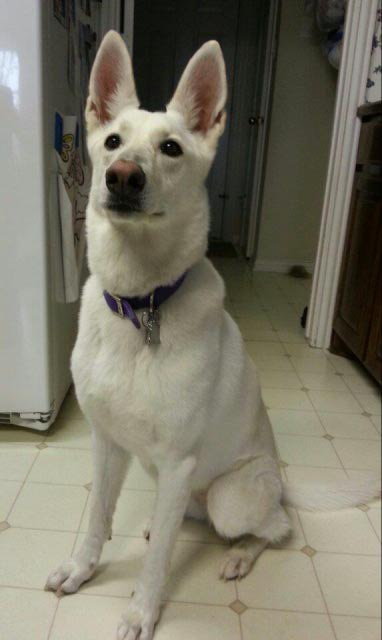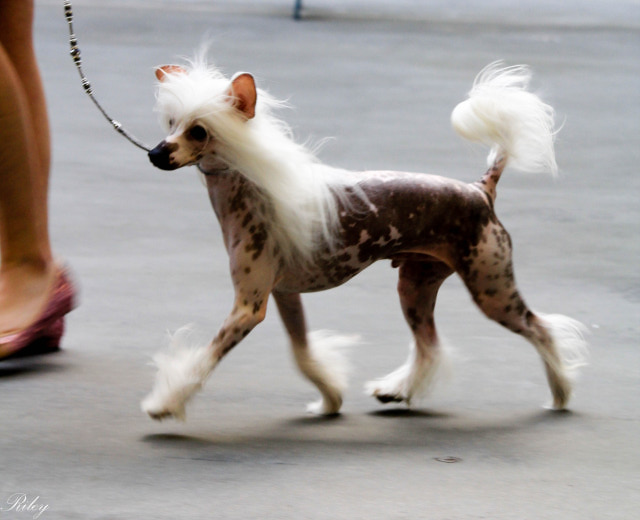QuestionI am writing because 2 of our 3 dogs have begun fighting with one another (started 10/31). We have 3 neutered males: a pug (8), pit mix (3-4ish), and American bulldog (3ish). We have had the pug the longest and two larger dogs for about 2 years (both rescues). They have all co-habited together peacefully but in the recent months the pit and bulldog have begun fighting.
A normal day consists of the dogs being walked, we leave for work and walked as soon as we return. They are not crated as the 2 big ones have some serious issues so they remain in the kitchen when no one is home.
The first time they fought was over food, we squashed that and it hadn't happened again, until Monday night. No food, toys, etc. were in the room and both dogs got into a fight. We successfully separated them and neither had any major issues. We kept them separate for an hour and brought them back together. We were watching them and the pit went after the bulldog for a 2nd time. This was was more difficult to break up and resulted in more sever injuries. There were 3 people over who don't live with us but the dogs are familiar with all of them. Outside of that is was a pretty routine night.
They have been separated for the most part since then. If we are gone they are not together anymore and last night was the first night we allowed them all to sleep in the room with us (which is normal, their beds are on the floor).
This morning at about 11:30 they returned from a walk and got into another fight. Not as sever but whatever issue they are having is obviously not resolved. We had friends come in from out of town last night and were at our house this morning. I don't see why other people would be an issue as it has never been before. They are used to having guests come in and out during the week. After the extra people left they were both in the kitchen and the bulldog bucked up to the pit. We are now having to keep them separate at all times.
I really do not know what to do. This is not something they have done in the past and I fear one of them will really hurt the other. None of them do well in crates and it's not right for us to have to separate them at all times, including when we are home. Do you have any suggestions? I have been reading blogs and following advice on how to re-socialize them to one another. When we do they lick each others wounds and act as if nothing happens. We thought we would be okay since they had been doing well together since last night, but it obviously isn't. I fear they are going to continue doing this and would like to know if there is anything we can do. I don't want to have to get rid of one because they are both needy and have mental ticks most rescue dogs have therefor they would be put down at a shelter and we do not know anyone personally who would be able to take them.
AnswerGreetings, and thank you for contacting All Experts!
First of all, thank you for rescuing dogs. I always like to hear when people rescue and do their best to provide happy homes. Dog fights can be ultimately quite scary to witness as you already know, and unfortunately, they can often lead to serious injuries. If you own a pack of dogs, which means more than one dog, the likeliness for fights to occur significantly heightens, especially if there are predisposing factors. I will list some predisposing factors for dogs fights worth mentioning.
1)Dogs of the same sex. Male and female dogs, therefore dogs of opposite sex are generally more likely to get along, than same sex dogs. Same sex aggression may also be more likely in certain breeds.
2) Dogs near the same age. When dogs reach social maturity together trouble may ensue. Often, the dogs may get along seemingly well during puppy hood, but then between the ages of about 2 and three years, conflicts may be more likely to occur.
3)Dogs of similar personality and rank. If you own a dog who is pushy and outgoing, there may be trouble if the other dog has the same energy type. Conflicts arise mostly between two dogs near in rank. If one dog is more assertive and the other is more submissive the chances of getting along may be better.
4) Dog of certain breeds. There are some breeds particularly prone to inter-dog aggression. For instance, the American Kennel Club states in regards to the Rottweiler ''An aggressive or belligerent attitude towards other dogs should not be faulted.'' Whereas, the United Kennel Club states in regards to the American Pitbull Terrier ''Because most APBTs exhibit some level of dog aggression and because of its powerful physique, the APBT requires an owner who will carefully socialize and obedience train the dog''.
5)Senior Dogs/Dogs With Health Problems. At times, a dog who is getting older or is suffering from health problems may be challenged by younger dogs who want to take over. This may cause fights, especially if the older dog is reluctant to give away its rank position
As seen, your pack of dogs have several predisposing factors. They are all males, two of them are very close in age, and you own breeds prone to same-sex aggression. It is not a surprise, therefore, that you are having problems. Managing a pack as such comes with big challenges.
While you mention the dogs have fought before over food, and now that you managed them, you noticed they had a fight where there was no visible trigger, it is important to recognize there was very likely a trigger but it went unnoticed. Triggers are often caused by access to resources. In a dog pack, there is generally a social ladder where there are leaders and followers. The leaders are those who have control over resources and the followers most likely accept this fact. The structure and order of dog packs, therefore, are meant to avoid conflicts which are often prevented by using body posture and warnings.
However, despite these attempts to diffuse and avoid conflicts, fights may eventually ensue, and the predisposing factors mentioned earlier (sex, age, breed) may be contributing factors. Let's take a look now at what type of resources dogs may be attempting to control and which triggers may cause a fight to ensue
Leaders of the pack, as mentioned earlier, control resources. They therefore believe that they should be the first to have access to such resources and defend them accordingly. Subordinate dogs of the pack normally respect and understand this privilege. However, at times, a dog may voluntarily, or sometimes involuntarily, challenge and attempt to gain access to these resources first, creating the grounds for conflict. Following are some of the most common resources causing conflicts.
Food
Toys
Higher or best sleeping spots
Access through doors
Access through tight passages
Attention from owners/guests
Once the resources are identified, it is easy to understand scenarios where fights are more likely to take place. Following are some common examples of triggers that may cause a fight to ensure due to a subordinate dog engaging in certain ''privileged'' behaviors.
Dog eats first
Dog gets favorite toy
Dog sleeps in most comfortable spot or highest spot
Dogs gets sent out the door first
Dog gets through tight passageway first
Dog gets attention from owners first
There may be many other triggers, but they may be very subtle and hard to notice. It could have been the bulldog went near or attempted to get near the people who were in your home first and the pit stopped him in his tracks.
The other fight upon returning home from the walk could have been triggered again by the bulldog entering the home first or accessing a favorite resting spot first. Or again, a fight over who gets attention first. But again, there may be other triggers we cannot be fully aware of.
It is great you are keeping them separated now and no longer in the kitchen together when you are away. You are absolutely right in being concerned for their safety as they can get seriously hurt. I can provide a few tips but I really would feel better if you would seek the assistance of a qualified dog behaviorist. Only a behaviorist can observe your dogs and get a good picture of what may be going on and provide you with the best advice on how to deal with the problem. Please understand that I can only do so much from a keyboard miles away and without observing the interactions between the dogs. Keep in mind that your dog's safety is at stake here.
It helps a lot to respect the hierarchy of your pack. For instance, try to recognize which dog has access to resources first and respect that position. Keep in mind though that this may be difficult to determine -And this is why I recommend a dog behaviorist to observe the interactions between your dogs- Some pack leaders give different value to some resources. For instance, some leaders may be particularly strict on getting attention from the owner first, but may be more lenient and laid back about getting out the door first or having access to a particular toy. It may get tricky at times determining who leads the pack.
If you suspect a particular dog is at the top of the hierarchy, try to prevent conflicts by respecting this dog's place in the pack. Therefore, feed him first, give him attention first, let him outdoors first. This may help prevent the pack leader from ''getting back'' at the dog who takes over the resources. Remember: dogs do not live in a democratic world, they have a hierarchical structure that needs respected .
Stan Rawlinson, one of the leading dog behaviorists and obedience trainers, also known as the ''Dog Listener'' suggests dog owners to not fuel the fire by feeling bad and ''rushing to protect the would-be subordinate from being "bullied". This can cause problems and potential fights. Here is a link from this respected author, while it addresses siblings I find it may be helpful for any case of inter-dog aggression:
http://www.doglistener.co.uk/aggression/rivalry.shtml
Dogs often engage a lot in ritualized aggression. This means they may invest in threatening body language to prevent fights but without actual fighting. Snarling, making hard eye contact, raising hairs, growling are all signs of ritualized aggression. However, ritualized aggression at times may lead to real aggression if the other dog does not back off, so catching a potential fight early can help diffuse it before it even starts. Watch for early warning signs and separate the dogs promptly and safely upon noticing them.
Your dogs may follow a hierarchy, but it is fundamental for them to know that at the very top you ultimately set the rules and one of your most important rules is to stop fighting. Make this clear. Your dogs should not be concerned about fighting with each other, rather they should worry more about you than themselves. You should be authoritarian enough to be able to step in and stop the dogs in their tracks by giving a firm command such as ''Lay down'' ''Leave it'' or ''Enough!''. Obedience training may help polish such commands and ensure you remain the firm and ultimate leader of your pack.
By knowing when fights more likely ensue you can now take an active role in preventing trouble. If dogs tend to fight during meal time, make sure they are all fed in different areas far from each other. No dog should be allowed to pester another dog during meal time. If toys are a trigger, make sure they are not left around, especially when you are not able to supervise. If attention is a trigger, pet in the right order or avoid petting at all when in the presence of each other. If two dogs engage in serious fights, keep them always separated or re-home one. As sad as it is they will be happier this way and prevent much heart aches. If you are concerned about your dog being put down at the shelter, consider a no-kill shelter or a rescue that will re-home to a one-dog family.
But as mentioned previously, before going to such drastic routes, it may help to discuss with a dog behavior consultant. You may find a reputable dog behavior consultant on the IAAMC website:
http://iaabc.org/consultants
I would like to leave you some reading material for multi-dog pack management by Trish King, Director of Behavior and Training at the Marin Humane Society :
http://www.positivelytrained.com/edu_resources/Living_with_Multiple_Dogs.pdf
I really hope this helps you and that some sort of solution can be found, as mentioned it is a difficult and serious problem, and there is really no easy quick fix. I highly recommend the dog behavior consultant route and serious management (keeping them separated for now). Separating two fighting dogs can put you into risk for re-directed aggression. This means that the two dogs fighting may be so aroused that if you get in between them, you may risk getting bit as well. Hoping the best, I send you my kindest regards,
Adrienne Janet Farricelli CPDT-KA
Disclaimer: Please consult with a dog behaviorist if your dog is displaying aggressive behaviors. Only a dog behaviorist may see and assess behaviors and offer the most appropriate behavior modification program tailored for your dog. Use extreme caution and make safety your top priority. By reading this answer you accept this disclaimer and assume full responsibility for any of your actions.

 Puppy Yelping
QuestionQUESTION: Hi! I have a 6 month old Cocker
Puppy Yelping
QuestionQUESTION: Hi! I have a 6 month old Cocker
 Designating bathroom area
Question
backyard
I have 2 medium mutts that are both b
Designating bathroom area
Question
backyard
I have 2 medium mutts that are both b
 Housebreaking My Puppy and Choosing the Right Fencing
Question
Woody
Hello. I have a four month old be
Housebreaking My Puppy and Choosing the Right Fencing
Question
Woody
Hello. I have a four month old be
 White German Shepherd Aggression
Question
Chloe
A little background on my dog Chl
White German Shepherd Aggression
Question
Chloe
A little background on my dog Chl
 Territory Marking
QuestionHi Kathleen and thank you in advance.
I have a
Territory Marking
QuestionHi Kathleen and thank you in advance.
I have a